


xxxxxThe scientist
Alexander Graham Bell was born in Edinburgh, Scotland, but went to
North America in 1870, and became a U.S. citizen in 1882. Born
into a family which was well known for its pioneer work in
elocution and speech training, he became deeply interested in this
work, and in 1872 opened a school in Boston to train teachers in
his father’s “Visible Speech”, a method which used a series of
written symbols to teach the deaf to speak. The school proved
highly successful, and in 1873 he was appointed professor of vocal
physiology at Boston University. It was there, while working on a
multiple telegraph, that he discovered the means by which sound
could be transmitted by electrical impulses. With the help of an
assistant, Thomas Watson, he perfected the idea and took out a
patent in March 1876.
The “telephone” was successfully demonstrated at an Exposition at
Philadelphia later that year, and the Bell Telephone Company was
founded in 1877 to promote this revolutionary break-
ALEXANDER GRAHAM BELL 1847
-
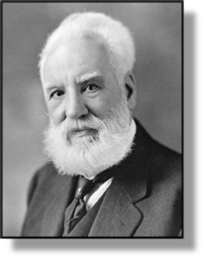 xxxxxThe scientist Alexander
Graham Bell was Scottish by birth, but became a U.S. citizen in
1882. A man of rare ability and abundant energy, he made important
innovations across a wide range of scientific research. Apart from
the telephone, which revolutionized the world of communications in
1876, he invented the photophone, the audiometer, the wax
recording cylinder and the induction balance, an instrument able
to locate metal objects in the human body. And later in his career
he made a number of important advances in the field of
aeronautics, including the development of the aileron and the
making of a hydrofoil speedboat.
xxxxxThe scientist Alexander
Graham Bell was Scottish by birth, but became a U.S. citizen in
1882. A man of rare ability and abundant energy, he made important
innovations across a wide range of scientific research. Apart from
the telephone, which revolutionized the world of communications in
1876, he invented the photophone, the audiometer, the wax
recording cylinder and the induction balance, an instrument able
to locate metal objects in the human body. And later in his career
he made a number of important advances in the field of
aeronautics, including the development of the aileron and the
making of a hydrofoil speedboat.
xxxxxBell was
born in Edinburgh, into a family which was well known for its
pioneer work in elocution and speech training. Hisxfather,
Alexander Melville Bell
(1819-
xxxxxFor a time
Bell taught music and elocution in Elgin, and then in 1868 went to
work at a school for the deaf in London. He attended University
College, London, for a time, but in 1870 the death of his elder
brother Melville from tuberculosis -
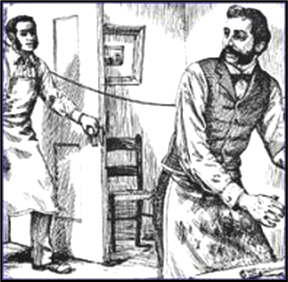
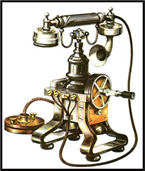 xxxxxIt was soon after this, whilst in the process of
working on a multiple telegraph, that Bell discovered the means by
which sound could be transmitted by electricity. Assisted then by
a young competent technician named Thomas
Watson (1854-
xxxxxIt was soon after this, whilst in the process of
working on a multiple telegraph, that Bell discovered the means by
which sound could be transmitted by electricity. Assisted then by
a young competent technician named Thomas
Watson (1854-
xxxxxLater that
year the apparatus was demonstrated at the Centennial Exposition
in Philadelphia, Pennsylvania. This introduced the telephone to
the world, and led to the establishment of the Bell Telephone
Company. In 1879 this company acquired the carbon microphone -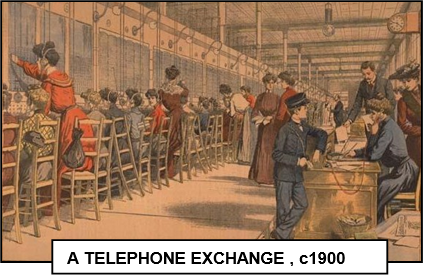 American
inventor Thomas Edison -
American
inventor Thomas Edison -
xxxxxWith the money now flooding in from his telephone system, Bell established a large research laboratory in Nova Scotia near his country retreat of Beinn Bhreagh (Gaelic for “beautiful mountain”) and in 1880, using the Volta Prize money awarded him by the Académie française, set up the Volta Laboratory in Washington DC. These institutions played a leading part in the research and development of a wide range of scientific improvements and innovations. His photophone, for example, transmitted speech via light waves, and his wax recording cylinder, patented under the term “graphophone”, proved a highly successful improvement over the metal foil cylinders used by Thomas Edison in his first phonograph of 1877. Later came the flat wax disc and the idea of impressing permanent magnetic fields on them as a means of reproducing sound. This idea was eventually abandoned, but it anticipated, in fact, the tape recorder, the hard drive and the floppy disc.
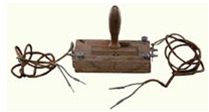 xxxxxOther devices invented included the induction balance
-
xxxxxOther devices invented included the induction balance
-
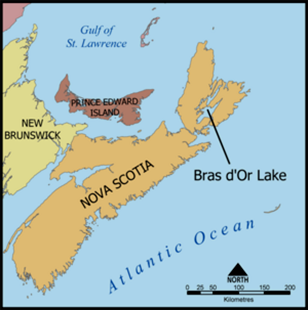 xxxxxBell died in August
1922, leaving a wife and two daughters. He was buried at the top
of Beinn Bhreagh mountain overlooking Bras d’Or Lake, Nova Scotia (see map). Upon
his death, telephones throughout the United States were stopped
from ringing for one minute as a silent tribute to their maker. By
then there were over 13 million telephones in service in the
advanced nations across the world.
xxxxxBell died in August
1922, leaving a wife and two daughters. He was buried at the top
of Beinn Bhreagh mountain overlooking Bras d’Or Lake, Nova Scotia (see map). Upon
his death, telephones throughout the United States were stopped
from ringing for one minute as a silent tribute to their maker. By
then there were over 13 million telephones in service in the
advanced nations across the world.
xxxxxAs noted
above, Bell’s patent for the telephone did not go unchallenged. A
number of scientists were working on the idea at around the same
time. Among these, three need to be mentioned. ThexItalian inventor Antonio Meucci (1808-
xxxxxIncidentally, Bell was born with just one Christian name, Alexander, but at the age of eleven his father allowed him to adopt the middle name of Graham, chosen out of admiration for Alexander Graham, a Canadian who was being treated by his father and had become a close friend of the family. ……
xxxxx…… Bell’sxmetal detector was
specifically made for President James
Garfield (1831-
xxxxx…… Bell demonstrated his telephone to the
renowned Irish scientist William Thomson (later Lord Kelvin), and
to Queen Victoria at a private audience at Osborne House, her home
on the Isle of Wight, 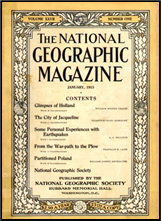 in
January 1878. She found the device “most extraordinary”. Later in
his career, however, Bell considered his famous invention to be an
intrusion on his work and privacy, and he refused to have a
telephone in his study! ……
in
January 1878. She found the device “most extraordinary”. Later in
his career, however, Bell considered his famous invention to be an
intrusion on his work and privacy, and he refused to have a
telephone in his study! ……
xxxxx…… Bellxplayed a big part in
the founding of the National Geographic Society.
He was a member from its beginning in 1888, and he served as its
president from 1896 to 1904. In the hands of his future son-
 xxxxx…… One of Bell’s most
famous pupils was the American Helen
Keller (1880-
xxxxx…… One of Bell’s most
famous pupils was the American Helen
Keller (1880-
Acknowledgements
Bell: photograph by the Moffett Studio, Chicago, artist unknown – Library and Archives of Canada, Ottawa. First Call: date and artist unknown. Exchange: contained in Le Petit Journal, c1900, a daily Parisian newspaper from 1863 to 1944, artist unknown. Map (Nova Scotia): licensed under Creative Commons – https://commons. wikimedia.org/wiki/File:Bras_d’Or. Keller: c1904, photographer unknown – Prints and Photographs Division, Library of Congress, Washington.
Vb-


